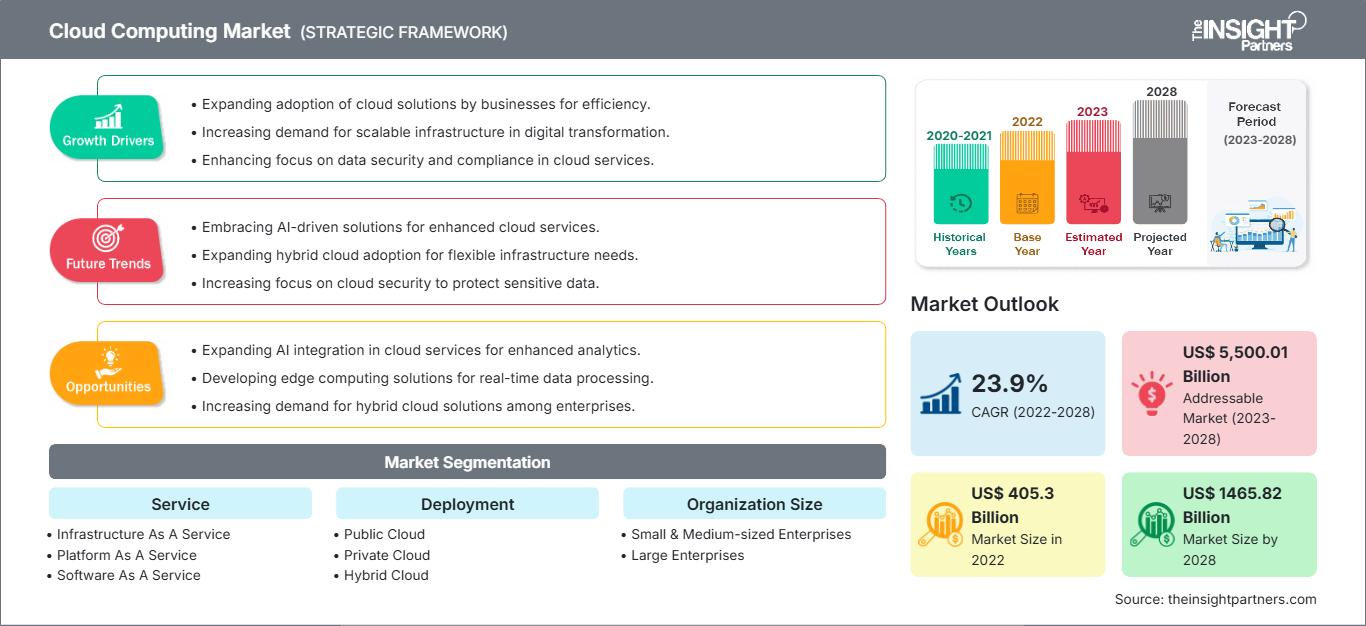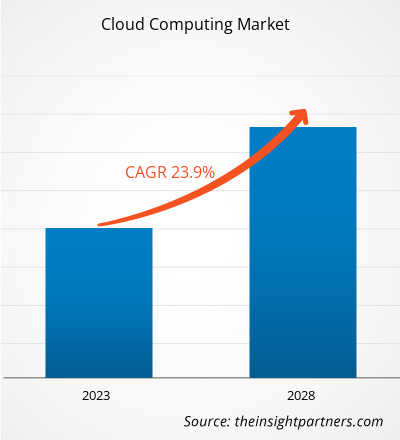The cloud computing market size is estimated to grow from US$ 405,295.8 million in 2022 to US$ 1,465,818.2 million by 2028; it is expected to register a CAGR of 23.9% from 2022 to 2028.
Analyst Perspective
The cloud computing market has witnessed significant growth in recent years, driven by the growing adoption of cloud computing among industries such as BFSI, IT, healthcare, government, and media. Growing implementation of 5G networks and technologies is boosting the cloud computing market growth during the forecast period. Rising digital transformation across the business and increasing mobile network adoption are anticipated to boost the market. Moreover, technological advancement, the growing use of IoT-connected devices, and the incorporation of artificial intelligence (AI), machine learning (ML), and big data technologies are creating opportunities in the market. However, increasing private and government investments in the adoption of cloud technologies are generating significant market growth opportunities during the forecast period.
Market Overview
Cloud computing refers to the on-demand delivery of IT services over the Internet at a pay-per-use (P2P) rate. Cloud computing allows the user to access technology services such as computing, storing, software, analytics, networking, intelligence, and databases. The technology offers significant benefits to the user including agility, cost-saving, elasticity, and productivity, among others, which increases its adoption among businesses across the globe. Cloud computing has become a crucial part of modern business operations due to its versatility, which has increased its rapid adoption across various industries, including BFSI, IT, healthcare, and others. Growing adoption of cloud storage services like Microsoft Azure Blob Storage, Amazon S3, and Google Cloud Storage drives the cloud computing market. These storage services provide security and scalability for storing all types, including documents, files, videos, and images, by eliminating the need for businesses to invest in on-premises storage infrastructure. These factors are anticipated to drive the cloud computing market during the forecast period.
Customize This Report To Suit Your Requirement
You will get customization on any report - free of charge - including parts of this report, or country-level analysis, Excel Data pack, as well as avail great offers and discounts for start-ups & universities
Cloud Computing Market: Strategic Insights

- Get Top Key Market Trends of this report.This FREE sample will include data analysis, ranging from market trends to estimates and forecasts.
You will get customization on any report - free of charge - including parts of this report, or country-level analysis, Excel Data pack, as well as avail great offers and discounts for start-ups & universities
Cloud Computing Market: Strategic Insights

- Get Top Key Market Trends of this report.This FREE sample will include data analysis, ranging from market trends to estimates and forecasts.
Market Driver
Growing Adoption of Cloud Technologies Among Businesses is Driving the Market
The increasing integration of cloud technologies across business operations is a pivotal factor fueling the growth of the global cloud computing market. Organizations across sectors are embracing digital transformation initiatives to enhance agility, scalability, and operational efficiency. Central to these efforts is the transition from traditional IT infrastructures to cloud-based environments. This shift enables enterprises to modernize legacy systems, streamline internal workflows, and support remote and hybrid work models. Cloud computing serves as a foundational enabler of next-generation digital services, offering embedded intelligence, seamless connectivity, and the flexibility to adapt to rapidly changing business needs. Unlike conventional models that rely heavily on physical infrastructure, cloud platforms offer scalable solutions that include Infrastructure-as-a-Service (IaaS), Platform-as-a-Service (PaaS), and Software-as-a-Service (SaaS). These services facilitate the automation of business processes, enhance cybersecurity protocols, and ensure business continuity through advanced data backup and disaster recovery systems. Businesses are increasingly leveraging multi-cloud and hybrid cloud strategies to optimize performance, manage costs, and ensure data sovereignty. Large enterprises, in particular, are adopting cloud-native architectures to support cross-functional teams, centralize data access, and manage complex workloads across geographically dispersed locations. According to the Flexera 2023 State of the Cloud Report, 75% of enterprises reported using Microsoft Azure, followed closely by Amazon Web Services (AWS) and Google Cloud, highlighting a competitive and mature cloud ecosystem. Moreover, partnerships and collaborations are further accelerating cloud adoption. For example, in February 2022, TecCentric and OmniClouds partnered to help businesses modernize their legacy internet infrastructure and migrate to cloud-based network systems, offering increased reliability and performance. Continued advancements in AI integration, edge computing, and serverless architectures are expected to reinforce the strategic importance of cloud computing. As companies seek to remain competitive and resilient in an increasingly digital economy, cloud adoption will remain a core driver of innovation, cost efficiency, and business agility.
Segmental Analysis
Based on deployment, the cloud computing market is segmented into public cloud, private cloud, and hybrid cloud. The hybrid cloud segment is projected to expand during the forecast period due to increased adoption among businesses across the globe. Hybrid cloud is an IT architecture that allows organizations to take advantage of and benefit from private and public clouds, such as incorporating workload portability, orchestration, and managing two or more environments. Hybrid cloud provides combined benefits of private and public clouds, including greater flexibility, scalability, and optimization of resources, which increases its adoption among businesses and drives the market. A hybrid cloud enables organizations to move applications and workloads between private and public clouds based on specific needs. This flexibility is valuable for managing different demands by optimizing business costs and fueling segment growth. A hybrid cloud provides the capability to have redundant and backup systems across different environments. In case of a failure or disaster in one location, workloads can be shifted to another environment, ensuring business continuity drives the market. A hybrid cloud allows organizations to optimize costs by choosing the most cost-effective platform for each workload. It also enables a pay-as-you-go model for resources consumed from public clouds, increasing business adoption.
Regional Analysis:
The market in Asia Pacific is expected to dominate in the near future owing to the growing adoption of advanced technologies such as AI, 5G, IoT, and edge computing across industries that drive the cloud computing market. Rising population, increasing government support, and growing investment from private sectors increase the adoption of new technologies by fueling the market. Moreover, growing adoption of public cloud services bolsters the cloud computing market in the region.
Many countries are implementing cloud computing technologies across industries such as BFSI, healthcare, education, manufacturing, and retail. For instance, in September 2022, Google LLC partnered with the National Association of Software and Service Companies (NASSCOM) to launch new cloud computing courses in India. This partnership increases demand for cloud computing in the educational industry and allows students to learn various advanced technology concepts including cloud basics, cloud computing, machine learning, and big data. The cloud computing market in Japan is projected to expand at a significant CAGR during the forecast period, development in the ICT sector and rising adoption of advanced technologies such as SDN, AI, IoT, and LTE. Expanding public cloud technologies encourage enterprises to shift their core applications to the cloud platform, which drives the market. Australia's cloud computing market is expected to grow soon due to increasing government support for adopting cloud-based technologies. The availability of cutting-edge and dependable cloud infrastructure is boosting the market in Australia. Most MSPs in Australia are assisting businesses in navigating different cloud options and moving their current workloads across several cloud environments, contributing to the adopting of the multi-cloud strategy in the country.
Key Player Analysis:
The cloud computing market analysis consists of players such as Amazon Web Services, Inc.; Microsoft Corp; Google LLC; Alibaba Group Holding Ltd; International Business Machines Corp; Salesforce Inc; Oracle Corp; SAP SE; Adobe Inc; and Workday Inc are among the key cloud computing market players profiled in the report.
Cloud Computing Market Regional Insights
The regional trends and factors influencing the Cloud Computing Market throughout the forecast period have been thoroughly explained by the analysts at The Insight Partners. This section also discusses Cloud Computing Market segments and geography across North America, Europe, Asia Pacific, Middle East and Africa, and South and Central America.
Cloud Computing Market Report Scope
| Report Attribute | Details |
|---|---|
| Market size in 2022 | US$ 405.3 Billion |
| Market Size by 2028 | US$ 1465.82 Billion |
| Global CAGR (2022 - 2028) | 23.9% |
| Historical Data | 2020-2021 |
| Forecast period | 2023-2028 |
| Segments Covered |
By Service
|
| Regions and Countries Covered | North America
|
| Market leaders and key company profiles |
|
Cloud Computing Market Players Density: Understanding Its Impact on Business Dynamics
The Cloud Computing Market is growing rapidly, driven by increasing end-user demand due to factors such as evolving consumer preferences, technological advancements, and greater awareness of the product's benefits. As demand rises, businesses are expanding their offerings, innovating to meet consumer needs, and capitalizing on emerging trends, which further fuels market growth.

- Get the Cloud Computing Market top key players overview
Recent Developments:
Inorganic and organic strategies such as mergers and acquisitions are highly adopted by companies in the cloud computing market. A few recent key market developments are listed below:
- In October 2023, British Telecommunications plc partnered with Google LLC to launch a new relationship centered on expanding innovation in cybersecurity applications. This partnership helps companies to serve private and public organizations in over 180 countries across the globe. British Telecommunications plc manages service delivery for Google’s Autonomic Security Operations (ASO) product.
- In June 2023, International Business Machines Corp acquired Agyla SAS to extend its localized cloud expertise in France. The acquisition supports International Business Machines Corp in broadening its hybrid multi-cloud services portfolio by enhancing the region's hybrid cloud and AI services.
- In February 2023, Tech Data launched cloud services for its customers in Australia. The company provides customized offerings for AWS and Microsoft’s Platform as a Service and Infrastructure as a Service business models.
- In February 2023, Akamai Technologies, Inc. introduced the Akamai Connected Cloud platform for content delivery, cloud computing, and security to protect applications against threats.
- In February 2023, Reply S.p.A. partnered with Amazon Web Services, Inc. to expand Storm Reply solution in North America. The partnership helps Reply S.p.A. offer and implement its cloud-based Storm Reply solution in its clients' businesses at the global level.
- In January 2023, Alibaba Group Holding Ltd unveiled the Apsara Developer Community to increase its offering of various developer tools and services. The community is a new center developed to support software developers by facilitating the advancement of the digital economy worldwide.
Frequently Asked Questions
What will be the global market size for the Cloud Computing market by 2028?
Which is the fastest growing regional market?
What is the estimated global market size for the Cloud Computing market in 2022?
What are the driving factors impacting the global Cloud Computing market?
I. COVID-19 Outbreak Fuels Demand for Cloud-based Solutions
II. Cost optimization Drives Cloud Uptake
What are the future trends of the Cloud Computing market?
Which countries are registering a high growth rate during the forecast period?
Which is the leading deployment model segment in the Cloud Computing market?
Which are the key players holding the major market share of Cloud Computing market?
What is the incremental growth of the Cloud Computing market during the forecast period?
- Historical Analysis (2 Years), Base Year, Forecast (7 Years) with CAGR
- PEST and SWOT Analysis
- Market Size Value / Volume - Global, Regional, Country
- Industry and Competitive Landscape
- Excel Dataset
Recent Reports
Testimonials
Reason to Buy
- Informed Decision-Making
- Understanding Market Dynamics
- Competitive Analysis
- Identifying Emerging Markets
- Customer Insights
- Market Forecasts
- Risk Mitigation
- Boosting Operational Efficiency
- Strategic Planning
- Investment Justification
- Tracking Industry Innovations
- Aligning with Regulatory Trends





















 Get Free Sample For
Get Free Sample For